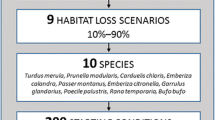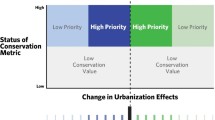Abstract
Anthropogenic disturbance occurring within urban ecosystems is often extreme and highly variable. A quantifiable measure of their effect on the persistence of urban wildlife populations would contribute to conservation efforts. This study suggests that population viability assessment, a commonly utilized modeling tool for creating management strategies for rare and threatened wildlife populations, is also appropriate in an urban context. It can be used to create proactive management strategies that quantify the impacts of anthropogenic disturbances and rank a range of management options within an active adaptive framework. To show this, population viability assessment and sensitivity analyses were run to forecast the population trends of a seemingly robust but isolated swamp wallaby (Wallabia bicolor) population living in peri-urban Sydney, Australia; a population exposed to anthropogenic disturbances from towns, hobby farms and roads. Modeling suggested this population was in a slow decline and that predictions were highly dependent upon stochastic events and the precision of reproduction rates. However, a number of management options are identified that will dramatically reduce the risk of total population decline, with complementary options utilized in tandem the most effective.
Similar content being viewed by others
References
Anderson DJ (1982) The home range: A new nonparametric estimation technique. Ecology 63:103–112
Augee ML, Smith B, Rose S (1996) Survival of Wild and Hand-reared Ringtail Possums (Pseudocheirus peregrinus) in bushland near Sydney. Wildlife Research 23:99–108
Ayala FJ, Gilpin ME, Ehrenfeld JG (1973) Competition between species: Theoretical models and experimental tests. Theor Popul Biol 4:331–356
Banks PB (2004) Population viability analysis in urban wildlife management: Modelling management options for Sydney's quarantined bandicoots. Royal Zoological Society of New South Wales, Mossman, NSW
Beissinger SR, Westphal MI (1998) On the use of demographic models of population viability in endangered species management. J Wildlife Manag 62:821–841
Ben-Ami D (2005) The behavioural ecology of the swamp wallaby, Wallabia bicolor, and its response to human induced disturbance. Thesis, University of New South Wales, Sydney, Australia
Benson D, Howell J (1994) Natural vegetation of the Sydney Area. National Herbarium of New South Wales, Vegetation of Ku-ring-gai Chase National park, and Muogamarra Nature Reserve, Sydney
Bertram BCR (1980) Vigilance and group size in ostriches. Animal Behav 28:278–286
Brook BW, O'Grady JJ, Burgman MA, Akekaya HR, Frankham R (2000) Predictive accuracy of population viability analysis in conservation biology. Nature 404:385–387
Burgman M, Ferson S, Akçakaya HR (1993) Risk Assessment in Conservation Biology. Chapman & Hall, New York
Crane P, Kinzig A (2005) Nature in the Metrop Sci 308:1225
Crebbin A (1982) Social organisation and behaviour of the swamp wallaby, Wallabia bicolor (Desmarest) (Marsupialia: Macropodidae) in captivity. Thesis, University of New South Wales
Csiro (1996) Australia State of the Environment 1996. CSIRO Publishing, Collingwood, Victoria
Czech B, Krausman PR, Devers PK (2000) Economic associations among causes of species endangerment in the United States. BioScience 50:593–601
Dickman CR (1994) Native mammals of western New South Wales: Past neglect, future rehabilitation? In: Lunney D, Hand S, Reed P, Butcher D (eds) Future of the Fuana of Western new South wales, The Royal Zoological Society of New South Wales, Mosman, pp 81–92
Edwards GP, Ealey EHM (1975) Aspects of the ecology of the swamp wallaby Wallabia bicolor (Marsupialia: Macropodidae). Austral Mammal 1:307–317
Fallding M, Hoye G, Turner R, Vollmer J, Berghout M (1994) Fauna Corridors and Vegetation Links in Hornsby Shire. Sydney
Fisher DO, Blomberg SP, Owens IPF (2003) Extrinsic versus intrinsic factors in the decline and extinciton of Australian marsupials. In: Proceedings of the Royal Society London B 270, pp 1801–1808
Flannery T (2004) Country. Text Publishing, Melbourne
Floyd RB (1980) Density of Wallabia bicolor (Desmarest) (Marsupialia: Macropodidae) in eucalypt plantations of different ages. Austral Wildlife Res 7:333–337
Foley JA, Defries R, Asner GP, Barford C, Bonan G, Carpenter SRF, Chapin S, Coe MT, Daily GC, Gibbs HK, Helkowski JH, Holloway T, Howard EA, Kucharik CJ, Monfreda C, Patz JA, Prentice C, Ramankutty N, Snyder P (2005) Global consequences of land use. Science 309:570–574
Garvey N (2005) The house made of bricks: Can low intensity fires provide refuge from high intensity fire? Mortality, migration and habitat use by the Swamp Wallaby, Wallabia bicolour, following low and high intensity fires. Graduate Diploma Thesis, University of New South Wales, Sydney
Grumbine RE (1990) Variable populations, reserve design, and federal land management: A critique. Conserv Biol 4:127–134
Harrington JR (1976) The diet of the swamp wallaby, Wallabia bicolor, at Diamond Flat NSW,. Thesis, University of New England, Armidale
Hollis CJ, Robertshaw JD, Harden RH (1986) Ecology of the swamp wallaby (Wallabia bicolor) in north-eastern New South Wales. I. Diet. Wildlife Res 13:335–365
Imhoff ML, Bounoua L, Ricketts T, Loucks C, Harriss R, Lawrence WT (2005) Global patterns in human consumption of net primary production. Science 429:870–873
Jones M, Rotherham ID (1998) ‘Eyes have they but they see not’: Changing priorities and perceptions of countryside in urban areas. Landsc Archeol Ecol 3:19–24
Kirkpatrick TH (1970) The swamp wallaby in Queensland. Queensl Agricult Journal 96:335–336
Lacy RC (1993) VORTEX: A computer simulation model of population viability analysis. Wildlife Rese 20:40–65
Lacy RC, Clark TW (1993) Simulation modelling of American marten (Martenes Americana) populations' vulnerability to extinction. Great Basin Natural 53:282–292
Leopold AS (1991) Engineering and conservation. In: Flader SL, Callicot JB (eds) The river of the mother of god and other essays University of Wisconsin Press, Madison
Lindenmayer DB, Lacy RC (2002) Small mammals, habitat patches and PVA models: A field test for model predictive ability. Biolog Conserv 103:247–265
Lindenmayer DB, Lacy RC, Pope ML (2000) Testing a simulation model for population viability analysis. Ecolog Applicat 10:580–597
Lindenmayer DB, Possingham HP, Lacy RC, Mccarthy MA, Pope ML (2003) How accurate are population models? Lessons from landscape-scale tests in a fragmented system. Ecol Lett 6:41–47
Lunney D, O'Connell M (1988) Habitat selection by the swamp wallaby, Wallabia-Bicolor, the red-necked wallaby, Macropus-Rufogriseus, and the common wombat, Vombatus-Ursinus, in logged, burnt forest near Bega, New-South-Wales. Austral Wildlife Res 15
Lunney D, Triggs B, Eby P, Ashby E (1990) Analysis of scats of dogs Canis familiaris and Foxes Vulpes vulpes (Canidae: Carnivora) in coastal forests near Bega, New South Wales. Austral Wildlife Res 17:61–68
Margules CR, Pressey RL (2000) Systematic conservation planning. Nature 405:243–253
Maxwell S, Burbidge AA, Morris K (1996) Action plan for Australian Marsupials and Monotremes. Department of the Environment and Heritage
Mccarthy MA, Burgman MA, Ferson S (1995) Sensitivity analysis for models of population viability. Biolog Conserv 72:93–100
Mccarthy MA, Burgman MA, Ferson S (1996) Logistic sensitivity and bounds for extinction risks. Ecolog Modell 86:297–303
Mcdonnell MJ (1997) A paradigm shift. Urban Ecosyst 1:85–86
Mcdonnell MJ, Pickett STA (1990) Ecosystem structure and function along urban-rural gradients: An unexploited opportunity for ecology. Ecology 7:1232–1237
Mcneely JA, Harrison J, Ingwall PD (1994) Protecting nature: Regional views of protected areas. World Conservation Union
Meek PD, Triggs B (1998) The Food of Foxes, Dogs and Cats on Two Peninsulas in Jervis Bay, New South Wales. In: Proceedings of the Linnean Society of New South Wales Vol 120, pp 117–127
Merchant JC (2002) The swamp wallaby, Wallabia bicolor. In: Strahan R (ed), The Mammals of Australia Reed New Holland, Sydney
Miller JM, Hobbs JR (2002) Conservation where people live and work. Conserv Biol 16:330–337
Mittermeier RA, Myers N, Mittermeier CG (2000) Hotspots: Earth's richest and most endangered terrestrial ecoregions. University of Chicago Press, Chicago
Myers N (1988) Threatened biotas: Hotspots in tropical forests. The Environmnt 8:178–208
Myers N (1990) The biodiversity challenge: Expanded hot spot analysis. The Environmnt 10:243–256
Newmark WD (1995) Extinction of mammal populations in western North American national parks. Conserv Biol 9:512–526
NSW NPWS (1998) Marramarra national park, muogamarra nature reserve and maroota historic site plan of management. NSW National Parks and Wildlife Management
NSW NPWS (2005) Atlas of New South Wales Wildlife. NSW Department of Environment and Conservation. NSW NPWS (2006) Mission statement
Osawa R (1989) Road-kills of the swamp wallaby, Wallabia bicolor, on North Stradbroke Island, south-east Queensland. Austral Wildlife Res 16:95–104
Osawa R (1990) Feeding strategies of the swamp wallaby, Wallabia bicolor, on North Stradbroke Island, Queensland. I: Composition of diets. Wildlife Res 17:615–621
Paplinksa JZ (2005) Seasonal breeding puberty and population genetics of the swamp wallaby (Walllabia bicolor). Thesis, University of Melbourne, Melbourne
Pimm SL, Raven P (2004) Extinction by numbers. Nature 403:843–845
Possingham HP, Lindenmayer DB, Norton TW (1993) A framework for improved threatened species management using Population Viability Assessment. Pacific Conserv Biol 1:39–45
Ramp D, Ben-Ami D (in press) The effect of road-based fatalities on the viability of an urban-fringe swamp wallaby population. J Wildlife Managem
Ramp D, Wilson VK, Croft DB (2006) Assessing the impacts of roads in peri-urban reserves: Road-based fatalities and road usage by wildlife in the Royal National Park. Biolog Conserv, New South Wales, Australia
Robertshaw JD, Harden RH (1986) The ecology of the dingo in north-eastern New South Wales. IV. Prey selection by dingoes and its effect on the major prey species, the swamp wallaby, Wallabia bicolor (Desmarest). Wildlife Res 13:141–163
Rotherham ID (1994) The role of local authorities in conserving biodiversity through environmental management and land-use planning. In: Proceedings of the Sixth International Congress of Ecology, 77
Rotherham ID (1999) Urban environmental history: the importance of relict communities in urban biodiversity conservation. J Pract Ecol Conserv 3:3–22
Shaffer ML (1981) Minimum population sizes for species conservation. BioScience 31:131–134
Strahan R (2002) The Mammals of Australia. In: Strahan R (ed) Reed New Holland, Sydney, pp 280–281
Taylor BD, Goldingay R (2003) Cutting the carnage: wildlife usage of road culverts in north-east New South Wales. Wildlife Res 30:529–537
Thomas J, Benson DH (1985) Vegetation Survey of Muogamarra Nature Reserve. National Herbarium of New South Wales, Royal Botanical Gardens, Sydney
Troy S, Coulson G (1993) Home range of the swamp wallaby, Wallabia bicolor. Wildlife Res 20:571–577
UNPD (2001) World Urbanization Prospects: The 1999 Revision. Key Findings. United Nations Population Division
van der Ree R (2004) The impact of urbanisation on the mammals of Melbourne—do atlas records tell the whole story or just some of the chapters? In: Lunney D, Burgin S (ed) Urban Wildlife: more than meets the eye Royal zoological society of New South Wales, Mosman, pp 195–204
Walters CJ, Holling CS (1990) Large-scale management experiments and learning by doing. Ecology 71:2060–2068
Watson R (1993) No more blackberries. Victor Natural 110:258–259
West S (1992) Home-range and habitat use in the Swamp Wallaby, Wallabia bicolor. Thesis, University of New South Wales
Williams J, Read C, Norton A, Dovers S, Burgman M, Proctor W, Anderson H (2001) Biodiversity, Australia State of the Environment Report 2001 (Theme Report). CSIRO on the behalf of the Department of Environment and Heritage
Author information
Authors and Affiliations
Corresponding author
Rights and permissions
About this article
Cite this article
Ben-Ami, D., Ramp, D. & Croft, D.B. Population viability assessment and sensitivity analysis as a management tool for the peri-urban environment. Urban Ecosyst 9, 227–241 (2006). https://doi.org/10.1007/s11252-006-9353-3
Published:
Issue Date:
DOI: https://doi.org/10.1007/s11252-006-9353-3




